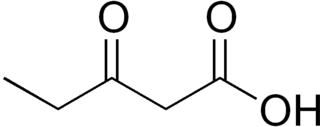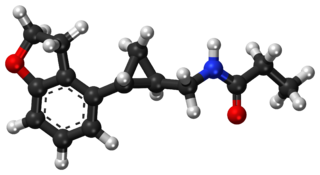
Lonafarnib, sold under the brand name Zokinvy, is a medication used to reduce the risk of death due to Hutchinson-Gilford progeria syndrome and for the treatment of certain processing-deficient progeroid laminopathies in people one year of age and older.

3-Oxopentanoic acid, or beta-ketopentanoate, is a 5-carbon ketone body. It is made from odd carbon fatty acids in the liver and rapidly enters the brain.
Pitolisant, sold under the brand name Wakix among others, is a medication for the treatment of excessive daytime sleepiness in adults with narcolepsy. It is a histamine 3 (H3) receptor antagonist/inverse agonist. It represents the first commercially available medication in its class. Pitolisant enhances the activity of histaminergic neurons in the brain that function to improve a person's wakefulness.

Tasimelteon, sold under the brand name Hetlioz, is a medication approved by the U.S. Food and Drug Administration (FDA) in January 2014, for the treatment of non-24-hour sleep–wake disorder. In June 2014, the European Medicines Agency (EMA) accepted an EU filing application for tasimelteon and in July 2015, the drug was approved in the European Union for the treatment of non-24-hour sleep-wake rhythm disorder in totally blind adults, but not in the case of non-24 in sighted people.

Ethyl eicosapentaenoic acid, sold under the brand name Vascepa among others, is a medication used to treat dyslipidemia and hypertriglyceridemia. It is used in combination with changes in diet in adults with hypertriglyceridemia ≥ 150 mg/dL. Further, it is often required to be used with a statin.

Axona was previously marketed as a medical food for the clinical dietary management of the impairment of metabolic processes associated with mild to moderate Alzheimer's disease. It is a proprietary formulation of fractionated palm kernel oil, a medium-chain triglyceride. Cericin, the company that makes Axona, states that during digestion, caprylic triglyceride is broken down into ketones, which provide an alternative energy source for the brain. Its use is based on the idea that the brain's ability to use its normal energy source, glucose, is impaired in Alzheimer's disease. Axona was first sold in March 2009.
Ixekizumab, sold under the brand name Taltz, is an injectable medication for the treatment of autoimmune diseases. Chemically, it is a form of a humanized monoclonal antibody. The substance acts by binding interleukin 17A and neutralizing it, reducing inflammation.
Polatuzumab vedotin, sold under the brand name Polivy, is a CD79b-directed antibody-drug conjugate medication used for the treatment of diffuse large B-cell lymphoma (cancer). It was developed by the Genentech subsidiary of Roche.

Acalabrutinib, sold under the brand name Calquence, is a medication used to treat various types of non-Hodgkin lymphoma, including mantle cell lymphoma (MCL) and chronic lymphocytic leukemia/small lymphocytic Lymphoma (CLL/SLL). It may be used both in relapsed as well as in treatment-naive settings.
Emapalumab, sold under the brand name Gamifant, is an anti-interferon-gamma (IFNγ) antibody medication used for the treatment of hemophagocytic lymphohistiocytosis (HLH), which has no cure.

Glasdegib, sold under the brand name Daurismo, is a medication for the treatment of newly-diagnosed acute myeloid leukemia (AML) in adults older than 75 years or those who have comorbidities that preclude use of intensive induction chemotherapy. It is taken by mouth and is used in combination with low-dose cytarabine.

Ivosidenib, sold under the brand name Tibsovo, is an anti-cancer medication for the treatment of acute myeloid leukemia (AML) and cholangiocarcinoma. It is a small molecule inhibitor of isocitrate dehydrogenase-1 (IDH1), which is mutated in several forms of cancer. Ivosidenib is an isocitrate dehydrogenase-1 inhibitor that works by decreasing abnormal production of the oncometabolite 2-hydroxyglutarate (2-HG), leading to differentiation of malignant cells.
Bempedoic acid, sold under the brand name Nexletol among others, is a medication for the treatment of hypercholesterolemia.
Inotersen, sold under the brand name Tegsedi, is a 2'-O-(2-methoxyethyl) (2'-MOE) antisense oligonucleotide medication used for the treatment of nerve damage in adults with hereditary transthyretin-mediated amyloidosis. The sequence is TCTTG GTTACATGAA ATCCC, where C is methylated C, and the first and third section are MOE-modified.
Bempedoic acid/ezetimibe, sold under the brand name Nexlizet among others, is a fixed-dose combination medication used for the treatment of high cholesterol. It is a combination of bempedoic acid and ezetimibe.

Pemigatinib, sold under the brand name Pemazyre, is an anti-cancer medication used for the treatment of bile duct cancer (cholangiocarcinoma). Pemigatinib works by blocking FGFR2 in tumor cells to prevent them from growing and spreading.
Lumasiran, sold under the brand name Oxlumo, is a medication for the treatment of primary hyperoxaluria type 1 (PH1).
Avalglucosidase alfa, sold under the brand name Nexviazyme, is an enzyme replacement therapy medication used for the treatment of glycogen storage disease type II.

Maralixibat chloride, sold under the brand name Livmarli, is a medication used to treat cholestatic pruritus in people with Alagille syndrome. Maralixibat chloride is an ileal bile acid transporter (IBAT) inhibitor.
Mosunetuzumab, sold under the brand name Lunsumio, is a monoclonal antibody used for the treatment of follicular lymphoma. It bispecifically binds CD20 and CD3 to engage T-cells. It was developed by Genentech.











